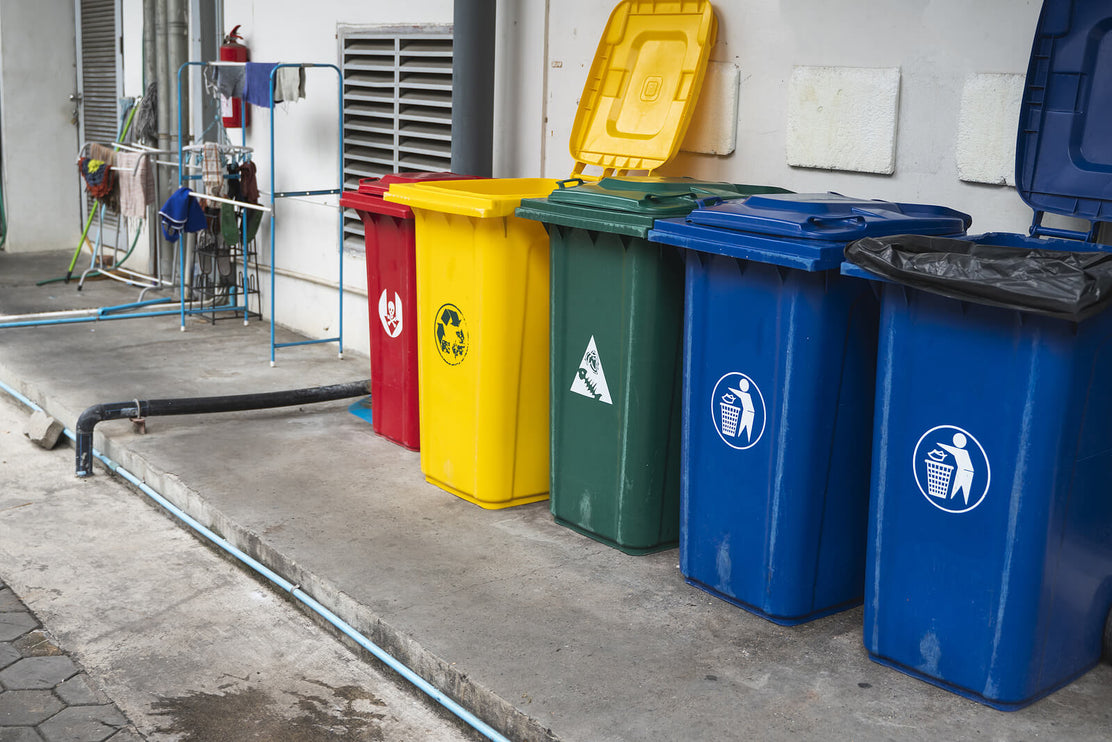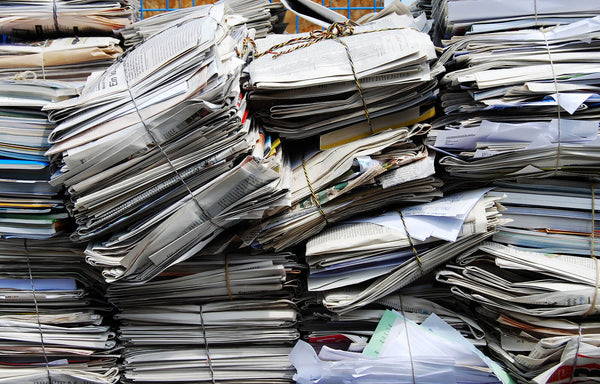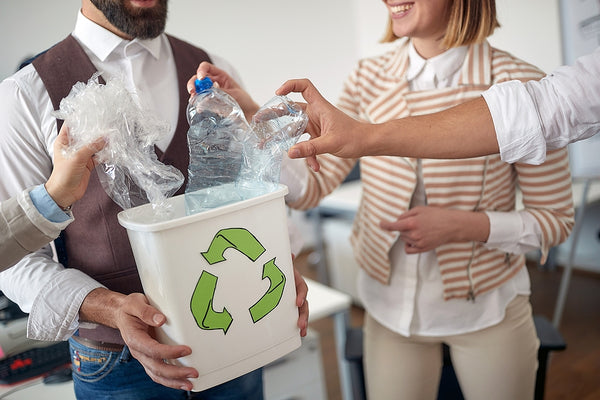Responsibly disposing of your rubbish in a bin is one thing, but do you go the extra mile by ensuring you put the correct waste in the right bin?
Without clear waste segregation channels, more waste ends up in landfills. This causes countless problems for the population and the environment.
We’ve put together this waste segregation guide to help households and commercial organisations get rid of their waste in an environmentally friendly manner.
What is waste segregation?
Waste segregation is the process of sorting waste into different waste streams based on its material type. The most obvious example is councils providing domestic households with general waste bins, recycling bins, garden waste bins (usually for an additional fee), and sometimes purple wheelie bins for collecting cardboard and paper.
Typically, waste is separated into dry waste and wet waste. Dry waste includes items not considered soiled or damp, such as clothing, empty bottles, glass, and rubber. Wet waste is the biodegradable rubbish we generate, like leftover food, hygiene products, and yard waste.
Managing and correctly segregating different waste stream types is pivotal to helping minimise the risk of cross-contamination — for instance, mixing hazardous and non-hazardous waste. This ensures there aren’t issues when the waste is later sorted at a recycling centre or waste facility.
Healthcare environments that handle clinical waste and construction firms using materials such as asbestos and cleaning substances have a legal duty to segregate their waste. These items are considered more dangerous and must be separated and disposed of carefully.
Why is waste segregation important?
Effective segregation of different wastes means landfill space is used to its maximum potential and prevents the world from being lumbered with rubbish. This stops recyclables from ending up with regular waste, minimising disposal costs and increasing recycling rates.
Classifying waste based on its properties and disposal needs is also better for the environment and protects public health. It helps disposal firms identify waste with more harmful materials and get rid of them safely.
What are the different types of waste segregation?
Waste segregation is identified and classified into several types. These categories are determined by their biological, chemical, and physical properties.
- Dry waste
- Wet waste
- E-waste – Any type of electrical and electronic equipment.
- Sanitary waste – Liquid and solid human waste, used menstrual hygiene products, etc. This also includes medical waste.
- Hazardous household waste – Items like cleaners, oils, and paints that contain corrosive, ignitable, reactive, or toxic ingredients.
- Hazardous waste – Waste such as construction and demolition waste that can harm humans or the environment and needs specialist disposal.
- Inert waste – A type of waste that doesn’t decompose. Examples include bricks, rubble, and sand.
What are the waste segregation guidelines in the UK?
We encourage all households in the UK to pay complete attention and care when disposing of rubbish so their waste matches the relevant bin. Don’t forget to encourage your children to be responsible for waste disposal, too.
Segregating your waste also helps your local council. Once their bin lorries have collected your non-recyclable waste or recyclable materials, they won’t require much organising at the waste treatment facilities.
Local authorities have been tasked with reducing their reliance on landfills, with the UK government setting a target for recycling 50% of household waste by 2024. Using the correct bin for your items and segregating recyclable materials helps reach this goal. Remember, you don’t always have to use a bin for waste disposal — food scraps and garden rubbish can easily be home-composted.
For businesses in the UK, implementing effective waste segregation practices isn’t just vital for sustainability, your green reputation, and economising your operations. It’s also a legal responsibility to ensure the waste you produce, store, transport, and dispose of doesn’t damage the environment. While businesses inevitably handle diverse waste types, all containers must be labelled clearly, and waterproof bins must be used if necessary.
In an attempt to drive up recycling rates, future government plans will impact businesses starting in 2025. Commercial entities with 10 or more full-time equivalent employees will have to begin separating dry recyclable and food waste streams for collection by March 31st 2025.
Benefits of waste segregation
By segregating waste correctly, households and businesses can improve their recycling rates and achieve zero landfill goals.
Other waste segregation benefits include:
- Transferring less waste to landfills. Landfills are associated with emitting toxic gases and causing disruption to local ecosystems.
- Conserving natural resources while reducing energy and emissions required to produce new materials.
- Increasing profits. Waste segregation can turn rubbish into riches by enabling us to identify valuable items like cardboard and metals. These can be sold to scrap dealers or recycling centres for cash.
- Economic growth. Composting and recycling create jobs.
- Heightening workplace health and safety by reducing the spread of infectious diseases, risk of accidents and injuries, and exposure to harmful chemicals.
How to segregate waste properly
Businesses should make it straightforward for employees to segregate their waste. Using colour-coding and clear signages on bins across your premises is a quick win, with regular monitoring of the waste streams to ensure different materials aren’t mixed up.
Hazardous waste requires greater diligence. It only takes one hazardous waste item to be jumbled up with a container of non-hazardous waste to contaminate the entire contents.
The best way to segregate waste is at the source, but businesses shouldn’t forget their legal obligations. This includes describing your waste correctly, so you must be alert to waste disposal habits in your workplace. For example, if employees put plastic in the paper bin (without your knowledge), you risk being fined.
Waste segregation bins
If we don’t start taking waste segregation seriously, we will see our natural areas, like mountains, meadows, and oceans, polluted with waste. Through an efficient colour-coded waste system, you can help achieve exemplary waste disposal and environmental standards.
With bins available in 10 different colours, including black, blue, orange, and purple, Wheelie Bin Solutions can help you separate and store your waste.
Contact us today for your waste segregation needs.








Craig Pryce
With over 17 years of experience in the waste and recycling industry, Craig is passionate about making recycling easier and reducing the negative impact of litter. He has been the managing director of Wheelie Bin Solutions (WBS) since January 2016, and prides the company on his expert knowledge, top-quality products, and customer service. His proudest moment was when WBS supported the 2012 Olympic Games, working in partnership with Contenur UK to supply over 9000 bin containers to all Olympic venues. Craig is always keen to share his knowledge, so whether you need advice about the benefits of a wheelie bin lock, or ideas for alternative uses for your wheelie bin, Craig will ensure your recycling and waste disposal habits are gold medal worthy.